 John Parr, Research Specialist in forage entomology and frequent contributor to the Ky Pest News
is retiring July 30 after 32 years with the Department of Entomology, College of Agriculture, University of Kentucky.
John Parr, Research Specialist in forage entomology and frequent contributor to the Ky Pest News
is retiring July 30 after 32 years with the Department of Entomology, College of Agriculture, University of Kentucky.
 John Parr, Research Specialist in forage entomology and frequent contributor to the Ky Pest News
is retiring July 30 after 32 years with the Department of Entomology, College of Agriculture, University of Kentucky.
John Parr, Research Specialist in forage entomology and frequent contributor to the Ky Pest News
is retiring July 30 after 32 years with the Department of Entomology, College of Agriculture, University of Kentucky.
John will re-arrange his schedule to spend more time on the family farm in Breckinridge County, hunting, fishing and grandparenting. He will be sorely missed in the Department of Entomology.
A retirement reception will be held Friday July 30, 1999 from 2:30 - 3:30 PM in the upper foyer of the Seay Auditorium. Everyone is welcome.
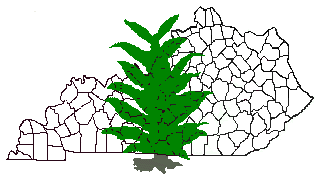
A blue mold advisory remains in place statewide,
with watches/warnings for large areas of the
Commonwealth, southern Indiana, southern Ohio,
and western West Virginia. However the potential
for blue mold development has declined sharply
during the past week in most areas. Statewide, root
diseases are causing much more damage than is
blue mold.
The very hot weather established over the region is greatly reducing the potential for blue mold development. However, cooler conditions with moisture have occurred in some fields (mainly irrigated crops or areas receiving locally heavy thunderstorms) to support very strong activity, so each grower must assess the risk on a field-by-field basis. Protective fungicide sprays are needed in crops conducive to blue mold development in communities under watches or warnings. Growers need to focus control efforts to crops set after June 1, especially those growing well, with irrigation, and ground suckers. Most crops set in May are now sufficiently mature that serious damage from blue mold is unlikely unless strong disease activity has been established for several weeks.
In many areas of Kentucky, most fields have very low levels of blue mold present, but little new inoculum has been produced this past week due to high temperatures. Dry foliage at night and high night time temperatures have been major limiting factors to development. However, some communities have had late afternoon showers and nightly fogs, where temperatures have been 20 degrees cooler than surrounding areas. Where temperatures have been dropping into the high 60's by midnight and foliage remained wet at night, blue mold remains a threat. As a result, very strong blue mold activity continues in a few plantings, mainly in low sites receiving irrigation or heavy rainfall during the past ten days.
Blue mold was confirmed during the week in southeastern Indiana, the first for the season. Strong, new sporulation was reported from the Quicksand Area of southeastern Kentucky late last week. Very strong activity is occurring in the burley production area of western North Carolina. Therefore, inoculum is present in the region should cooler temperatures and moisture return.
Status reports by Extension Area or state/region are as follows.
Foliar fungicide sprays, applied at 5-7 day intervals, are recommended for communities under a watch or warning and all irrigated crops in areas under advisory. Follow label directions as to spray volume, fungicide rate, numbers of applications, nozzle arrangements, and days-to-harvest intervals. Acrobat MZ will be the most effective fungicide. Even in areas under watches or warnings, many fields will not warrant sprays because the tobacco is not growing well enough to economically support the cost of a spray program. Crops with a yield potential under 2500 lbs/A are unlikely to benefit economically from a regular spray program with Acrobat MZ. Exceptions would be crops planted to low plant populations, less than 6000 plants/acre, where very lush growth is present. Growers need to be paying particular attention to later crops, because large amounts of inoculum can be generated from older crops (without much damage to these) and from suckers.
![]() For current blue mold information, go to the Ky Blue Mold Warning System at:
For current blue mold information, go to the Ky Blue Mold Warning System at:
http://
www.uky.edu/Agriculture/kpn/kyblue/kyblue.htm
 Yield losses to tobacco aphids occur over a relatively
long period of time. They begin about 4 to 6 weeks
after the crop is set and end with topping. A major
portion of the aphids present on an infested plant
end up on the ground when the top is broken out.
Those left on lower leaves will continue to live and
feed but will not reduce yield.
Yield losses to tobacco aphids occur over a relatively
long period of time. They begin about 4 to 6 weeks
after the crop is set and end with topping. A major
portion of the aphids present on an infested plant
end up on the ground when the top is broken out.
Those left on lower leaves will continue to live and
feed but will not reduce yield.
Late set tobacco crops tend to have much greater numbers of aphids per plant than do early crops. Consequently, yield losses usually are greater. Large numbers of winged aphids are leaving maturing tobacco. They will settle on the smaller plants and begin to produce live young. More aphids on smaller plants typically means smaller, lower weight leaves. Check late crops carefully and use the 20% infested plant treatment guideline to time insecticide applications.
Hornworms and grasshoppers are the most common insect pests that are active in tobacco after the crop is topped. They can be very damaging during the 3 to 4 weeks the crop remains in the field before harvest. Often an insecticide is included when the sucker control chemical is applied. Depending on the product used, this approach should control insects present at the time of application. However, the residual effect will not last for the entire time the crop stands before harvest. Sunlight and weathering will gradually reduce the amount of chemical present on the leaf. This is a natural occurrence and generally means that pesticide levels should be at acceptable levels if label rates and harvest intervals are followed.
Most insecticides used on tobacco should be
effective for about a week. After that time, weekly
field checks should be made to detect any late pest
buildups.
 Hornworm moths fly over a relatively
long period of time so worm season can occur over
an extended interval.
Hornworm moths fly over a relatively
long period of time so worm season can occur over
an extended interval.
Grasshoppers have been abundant this summer also and can cause extensive leaf loss in tobacco fields. They usually occur in grassy pastures and can be driven into crop fields as hay is cut or as drought reduces their food supply. Check for grasshoppers in hay fields and pastures adjacent to tobacco. An average of 10 or more hoppers per square yard can mean trouble if they move to tobacco. It is much better to control these insects before they get into the crop than to try a rescue application later. Cythion (malathion) and Sevin are labeled for grasshopper control in pastures and hay fields. See the label for rates and restrictions. Dipel and Tracer are effective and safe insecticides for hornworm control but will not kill grasshoppers. If both of these insects are active in tobacco, then Orthene is the best choice. Products containing endosulfan (Golden Leaf and Thiodan, for example) should not be applied within 28 days of harvest, even though they have a 5 day harvest interval on the label. The 28 day interval is recommended because of potential residue problems.
![]() Last year there were a lot of rumors that Roundup-
ready (RR) soybeans were more severely affected by
certain soybean diseases than were their non-RR
ready counterparts. Interestingly enough, this
concern has a very slight basis in reality, but the true
situation is vastly more optimistic than the rumors.
My purpose in writing this article is to address these
rumors and, hopefully, put all of them to "bed".
Last year there were a lot of rumors that Roundup-
ready (RR) soybeans were more severely affected by
certain soybean diseases than were their non-RR
ready counterparts. Interestingly enough, this
concern has a very slight basis in reality, but the true
situation is vastly more optimistic than the rumors.
My purpose in writing this article is to address these
rumors and, hopefully, put all of them to "bed".
1. During last year's Princeton Field Day, I was getting a lot of comments and questions about a "virus disease" that was hammering RR soybeans. Everyone had heard it was "bad" but nobody had any first-hand experience with the "problem". Along the same line, nobody could bring me a sample to look at. To my knowledge there are no virus disease problems in RR soybeans that are not also problematic in non-RR soybean. Thus, as far as I know, there is no basis to this rumor.
2. Another rumor was that ALL RR soybean varieties are highly susceptible to soybean cyst nematode and, thus, they will be severely damaged if SCN is above the damage threshold in a field. I have first-hand experience to know that this rumor is not true. There are quite a few SCN-susceptible- RR soybean varieties, but I have tested several excellent SCN-resistant RR soybeans. According to UK Soybean Breeder Dr. Todd Pfeiffer, "the first transgenic event which added the RR gene into soybean occurred in Asgrow (A) 5403. This was the original source of the RR gene provided to PRIVATE breeders by Monsanto". A5403 is resistant to races 3,14 of SCN. However, because of certain restrictions Monsanto has placed on use of the RR gene, any line or variety must be a specified number of backcrosses away from A5403 before variety testing or release is legal. This has the effect of significantly reducing the influence of A5403 genetics in any developed RR variety. For example, Paul Reese, a Monsanto employee, estimates that most current (private) RR varieties will have less than 6% A5403 in their background and that 40% of those will have less than 4% A5403. With this in mind, the main reaction to SCN in any RR variety would be based on what other lines and varieties the breeders worked with when developing each new RR variety. A certain percent of any individual RR bean will be A5403 (at most 12%), but the basis of the SCN reaction is the other breeding material that was used in the developmental process. In other words, the SCN situation is the same as with non-RR soybeans: some varieties are highly resistant to SCN, some are highly susceptible, and some are intermediate. If you have a question about the SCN reaction of the RR soybean you are growing this year, your seed dealer should be able to easily provide you with this information. Note that the above discussion only deals with private RR varieties. Public breeders received the RR gene in the public variety, Resnik, so the A5403 link does not apply to public RR releases.
3. The final rumor was that ALL RR soybean varieties are highly susceptible to soybean sudden death syndrome (SDS). The basis of this rumor is that A5403 (see above connection with RR soybeans) is known to be highly susceptible to SDS. So, in fact, there is a biological basis for this rumor in privately- developed RR varieties. However, due to the limited influence of A5403 on the overall genetics of those RR varieties (see no. 2, above), the SDS reaction will be more influenced by the other material soybean breeders used to develop their RR varieties. Thus, the situation is the same as was described for SCN, where there will be highly variable SDS reactions for current RR soybean varieties.
*I wish to thank Dr. Todd Pfeiffer in the UK Department of Agronomy for providing me with much of the information used in this article.
![]() It is beginning to look as if we are going to be sitting
under this high pressure system for a good while
yet. The resulting lack of rain could bring us an
additional pest in soybeans spider mites. This is a
relatively rare pest of soybeans and is almost never
found in the absence of drought conditions. There
have been reports of cotton fields in NE Arkansas
requiring treatment but nothing really close to us
and cotton is quite a different crop. It is a little too
early to be getting worried about spider mites here
but it never hurts to be prepared and to begin
looking before you are caught with the damage
already done.
It is beginning to look as if we are going to be sitting
under this high pressure system for a good while
yet. The resulting lack of rain could bring us an
additional pest in soybeans spider mites. This is a
relatively rare pest of soybeans and is almost never
found in the absence of drought conditions. There
have been reports of cotton fields in NE Arkansas
requiring treatment but nothing really close to us
and cotton is quite a different crop. It is a little too
early to be getting worried about spider mites here
but it never hurts to be prepared and to begin
looking before you are caught with the damage
already done.
Spider mites are very small and are generally not noticed until damage is visible. You must take a close look at the undersides of bean leaves to find this pest, so even a general walk through of a soybean field that would allow one to see most of the problem pest could still result in missing this pest. About the easiest way to look for spider mites is to shake a few leaves over a piece of white paper. Then watch for black specks moving across the paper. If you find this, use a hand-lens to check the moving specks and the undersides of the leaves.
More noticeable are the damage symptoms, but these symptoms are often written off as drought stress. The plants take on a yellow or 'bronzed' appearance. Early damage will usually appear along field edges and borders of waterways or around clumps of grassy weeds that are drying down. The mites feed on individual leaf cells sucking out their contents, this results in the yellow color instead of the normal green.
This is not an easy pest to deal with and makes a management decision difficult in these times of low commodity prices. The best treatment is sufficient rainfall. Keep your eyes open, and hope for return to adequate rain before the problem occurs.
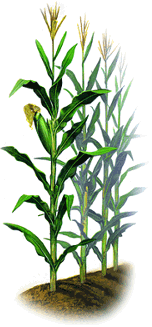
 Near record trap catches are being recorded for
Southwestern corn borer in the Green River area of
the state. Traps maintained in McLean, Daviess, and
Henderson counties have been catching second
generation moths for over a week. Second
generation Southwestern corn borer larvae can be
very damaging in September and October when
they begin to girdle plants. Fortunately, most of the
corn in the area was planted on time which should
make it less attractive for egg laying by this
generation. However, late planted field, read that as
fields planted after May 1, that did not use
YieldGard or StarLink Bt hybrids should be
monitored carefully for this pest.
Near record trap catches are being recorded for
Southwestern corn borer in the Green River area of
the state. Traps maintained in McLean, Daviess, and
Henderson counties have been catching second
generation moths for over a week. Second
generation Southwestern corn borer larvae can be
very damaging in September and October when
they begin to girdle plants. Fortunately, most of the
corn in the area was planted on time which should
make it less attractive for egg laying by this
generation. However, late planted field, read that as
fields planted after May 1, that did not use
YieldGard or StarLink Bt hybrids should be
monitored carefully for this pest.
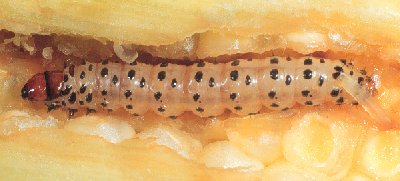 With low corn prices, some producers have
indicated that they will let their corn dry as long as
possible in the field to avoid drying costs. While this
will reduce inputs costs, producers need to realize
that the longer they wait to shell corn, the greater
the potential for corn borer harvest losses.
Producers are encouraged to scout fields for this
pest, identify which fields are most heavily infested,
and harvest the worst fields before serious stalk
lodging occurs.
With low corn prices, some producers have
indicated that they will let their corn dry as long as
possible in the field to avoid drying costs. While this
will reduce inputs costs, producers need to realize
that the longer they wait to shell corn, the greater
the potential for corn borer harvest losses.
Producers are encouraged to scout fields for this
pest, identify which fields are most heavily infested,
and harvest the worst fields before serious stalk
lodging occurs.
Producers in the Lake Cumberland area have
reported unusually high levels of stink bug damage
to pepper fruit. Stink bug damage to pepper is very
similar to that on tomato. Stink bug feeding causes a
light colored corky area just underneath the skin of
the fruit. These damaged areas are visible through
the skin.
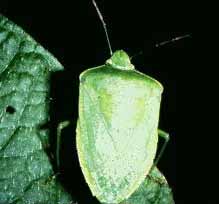
Generally, stink bug numbers and their damage on various crops are up this year across the state. Damage was common early in the season on corn. The same species of stink bugs, the brown and green stink bugs, attack peppers. The past two mild winters undoubtedly have contributed to the increase in stink bug numbers. While there has not been similar reports of stink bug damage to tomatoes, stink bug damage to tomatoes picked in the breaker stage is not readily discernable.
Adult stink bugs migrate from weedy areas into pepper fields, particularly when the weedy plants begin to decline. Continual weed management throughout the season around fields helps to reduce stink bug immigration into fields. In terms of insecticidal control, endosulfan (Thiodan, Phaser) and the pyrethroid insecticides (Ambush, Asana, Baythroid, Pounce) are the most effective insecticides registered for peppers against stink bugs, but they provide only fair to good control of stink bugs. When scouting peppers for stink bugs and their damage in order to make control decisions, keep in mind that the presence of fruit damage does not mean that stink bugs are necessarily still active.

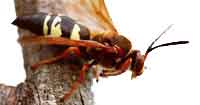 Cicada killers are now flying, prompting frantic
calls from some homeowners. Despite their
menacing appearance (up to 2 inches long with
rusty red head/thorax, amber-yellow wings, and
black and yellow striped abdomen), the wasps
seldom sting unless handled or otherwise molested.
Cicada killers are now flying, prompting frantic
calls from some homeowners. Despite their
menacing appearance (up to 2 inches long with
rusty red head/thorax, amber-yellow wings, and
black and yellow striped abdomen), the wasps
seldom sting unless handled or otherwise molested.
Cicada killers do not live in communal nests like hornets or yellowjackets. They overwinter as larvae within cocoons, deep in the soil, emerging as adults during July. The females feed, mate, and excavate burrows in the ground about « inch in diameter, ending in a series of brood chambers. Excess soil is pushed out of the burrow, leaving a small, U- shaped mound of dirt at the entrance. Each female excavates numerous burrows and provisions them with adult cicadas which she ambushes, paralyzes with her venom, and stuffs into individual brood chambers. She then lays an egg on top, backs out, and seals the cell behind her. The egg hatches within a few days and the hungry larva devours the offering, eventually transforming into a pupa the following spring.
Management - Cicada killers seldom sting and the females normally do not defend their burrows. The males, while incapable of stinging, sometimes dive- bomb passers-by, or hover about one's body. Insecticide treatment may be warranted where the soil burrows become unsightly. Individual burrows can be effectively dusted or sprayed with most yard insecticides, including Sevin, Dursban or diazinon. Large numbers of nests may need to be treated with a broadcast application to the surface of the turf.
Last week's Kentucky Pest News included an article on preventive control of gray leaf spot on perennial ryegrass. Although the pathogen has not yet been detected this season in Kentucky swards, it is very possible that it has begun activity. Thus, I recommended beginning a preventive fungicide program last week.
It is not too late to begin a preventive program even now, according to the guidelines provided last week. However, if a golf course superintendent finds him/herself in a situation where disease activity has already begun and one can find a noticeable amount of leaf spotting and leaf blighting, a curative approach is called for. Based on the research and general experience to date, I would expect that the best way to begin the spray program is with a mixture of fungicides, for reasons of both enhanced disease control and minimizing the risk of fungicide resistance.
Reasonable choices for the first spray would include: Spectro 90WDG at 8 oz/1000 sq ft, or Heritage at 0.2 oz plus Daconil Ultrex at 3.7 oz. After that, one could switch to a program along the lines of what was described in last week's article.

Symptoms of aster yellows disease may appear this time of year in herbaceous flowering plants in the garden. Once thought to be caused by a virus, aster yellows disease is caused by a bacteria-like organism called a phytoplasma. Aster yellows outbreaks are infrequent here, but when they do occur, they can cause considerable damage. Aster yellows is spread by leafhoppers which can acquire the phytoplasma while feeding on diseased plants and 10-45 days later transfer the pathogen to new host plants. The aster yellows phytoplasma can be transmitted a great distance (from one state to another) by means of these vectors.
Aster yellows host plants. This disease has a very wide host range. Ornamentals such as aster, begonia, chrysanthemum, coreopsis, dahlia, delphinium, gaillardia, gerbera, gladiolus, gloxinia, hydrangea, marigold, pansy, petunia, phlox, primrose, purple coneflower, rudbeckia, salvia, and vinca are susceptible. In addition many garden vegetables such as carrot, lettuce, onion, spinach, potato, and tomato can be infected. Weeds that may become infected and serve as hosts for aster yellows include black-eyed Susan, dandelion, field daisy, thistle, wide-leafed plantain, wild carrot, and wild chicory.
Symptoms. The aster yellows phytoplasma grows in the phloem, disrupting plant hormone flow and resulting in plant growth distortions. Yellows diseases are known to cause yellowing, bronzing, stunting, and witches brooms (abnormal proliferations of shoots). In addition, stiff, upright, purple foliage may be observed, or tiny, distorted leaves may appear in the center of flowers. Flower sterility and flower greening symptoms are also common.
Disease management. Aster yellows cannot be cured, so infected plants are best pulled up and discarded to prevent leafhoppers from spreading the disease to nearby plants. Fortunately, the disease is sporadic enough that usually only a few plants in a bed may be affected. Removal of weeds near the garden which may be secondary sources of the pathogen is also needed. Insecticides can deter leafhopper vectors, but would be most useful if applied early in the season to nearby weeds which are sources of the phytoplasma.
Grub treatments must be properly timed in order to be effective and to minimize risk to animals. Make applications as soon as heel fly activity ceases, usually by the last week in July. Do not treat after October 31, preferably not after October 15. Cattle grub treatments applied as pour-ons, spot-ons, injections, or sprays are systemic insecticides which travel within the animal's bloodstream. See ENT- 11, Insecticide Recommendations for Beef Cattle. Late treatments, applied after grubs are already in the animal's back, may cause toxic reactions and must be avoided. When using Ivermectin in the fall worming, there is no need to apply a product for grub control.
Do not treat calves less than 3 months old or cattle under stress from illness, shipping, castration, dehorning, etc. Read and follow label directions for all cattle grub treatments.
We have diagnosed several cases of Rhizoctonia root and stem rot on soybean. Tobacco diseases this week have included black shank, soreshin, blue mold, Fusarium wilt, angular leaf spot and target spot.
On fruits we have seen bitter rot of apple and brown rot on nectarine. On vegetables we have seen blossom end rot and southern blight on pepper; a virus complex on pumpkin; Alternaria leaf blight on cantaloupe; early blight, Septoria leaf spot, bacterial canker, Fusarium wilt, root knot nematode, walnut wilt, uneven ripening, stink bug.
Diseases diagnosed on ornamentals this week included bacterial blight on geranium; white rust on morning glory; Rhizoctonia root rot on hydrangea; Phytophthora root rot on rose; powdery mildew on dogwood; Macrophoma twig blight on boxwood; anthracnose and summer patch on turf.
WORKSHOP HELD ON SOUTHERN/ APPALACHIAN APPLE PRODUCTION
OPMP hosted a workshop in June addressing the critical pest management needs that may arise as a result of the Food Quality Protection Act (FQPA). The 12-member work group focused only on apples grown in Southern and Appalachian regions to develop proposals to lessen or eliminate dependency on organophosphate (OP) insecticides and reduce OP residues on apples. Participants included growers, university faculty, an orchard consultant, and representatives from the National Center for Food and Agricultural Policy, US Apple, EPA and USDA. A guidance document will be produced as a result of this workshop. A similar workshop on peaches was held this month (July) in California.
SOME CROP PEST MANAGEMENT PROFILES ON LINE
Crop profiles are being developed by each state to summarize pest management practices and problems at the state level. Posted on the Web at http://ipmwww.ncsu.edu/opmppiap/proindex.ht m , they now total 116. Kentucky has posted six profiles addressing apples, alfalfa, corn, soybeans, tobacco and wheat. Additional important horticultural commodities are planned for future profiles.
METHYL BROMIDE PHASE-OUT AMENDED
Effective July 1, 1999 is EPA's final rule revising the
phase-out of methyl bromide:
1) 25 percent reduction in 1991 baseline levels for
1999
2) 50 percent reduction in 1991 baseline levels for
January 1, 2001
3) 70 percent reduction in 1991 baseline levels for
January 1, 2003
4) 100 percent reduction in 1991 baseline levels for
January 1, 2005 with emergency and critical use
exemptions permitted. EPA plans to exempt
quantities of methyl bromide used in the U.S. for
quarantine and preshipment. The proposal is on
the Web at http://www.epa.gov/fedrgtr/EPA-
AIR . Click on June 1, 1999, and select
"Protection of Stratospheric Ozone..." Contact:
Tom Land, 202-564-9185, or the Ozone Hotline,
1-800-269-1996.
AZOXYSTROBIN IS PHYTOTOXIC TO SEVERAL APPLE VARIETIES
An EPA alert warns of adverse effects to MacIntosh and MacIntosh-derived varieties of apples from exposure to azoxystrobin (Abound, Heritage and Quadris). Sold by Zeneca Ag Products, azoxystrobin is registered on grapes, several tree nuts, stone fruit, cucurbits, etc. but not on apples. Effects on apple trees include necrosis, leaf drop and fruit drop. EPA may further restrict use of this fungicide. The current label warns about spray drift and prohibits sprayers used with azoxystrobin for subsequent spraying of apple trees. Contact: John Bazuin, 703-305-7381 or bazuin.john@epa.gov .

| UKREC-Princeton, KY, July 17 - 23 | |
| European Corn Borer | 3 |
| Corn Earworm | 32 |
| True Armyworm | 2 |
| Southwestern Corn Borer | 413 |
| Fall Armyworm | 5 |
| Black Cutworm | 1 |
Lee Townsend
Extension Entomologist